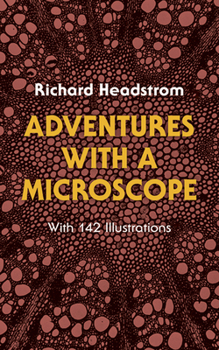Adventures with a Microscope
Select Format
Select Condition 
Book Overview
With a simple microscope and this book, you can embark on 59 wonderful adventures in the natural world -- make discoveries about the structures of numerous microscopic animals; find out what everyday objects and foods really look like at the cellular level; gain an understanding of how to prepare specimens and slides; and learn about many scientific phenomena such as how a fly can walk upside down on the ceiling. It's all here in simple-to-understand language and 142 clear line drawings. The author first examines under the microscope such everyday objects as a human hair, air bubble, scale of a herring, poppy seed and sugar crystal, and then offers through-the-microscope views of such creatures and objects as the water flea, hydra, house fly, amoeba, euglena, volvox, diatoms, desmids, algae, blood corpuscles, honey bee, rotifer, water-mites, potato starch, and other food substances, lichen, paramecium, coffee, sponge, chalk, yeast, bacteria, mustard, pepper, bryozoan, moss, mushroom, molds, cotton, and other textile fibers, ferns, dragon-flies, flea, spider, roots, and other plant structures, paper, aphid, fingerprints, nervous system of the grasshopper, and more. Richard Headstrom, formerly associated with the New England Museum of Natural History and an experienced teacher and writer on natural science for young people, has made this book simple enough for any beginner at home as well as interesting for more experienced students and lay readers. Enjoyable and instructive, these adventures with a microscope will appeal to all who are curious about what there is to see beyond the range of the naked eye.
Format:Paperback
Language:English
ISBN:0486234711
ISBN13:9780486234717
Release Date:June 1977
Publisher:Dover Publications
Length:272 Pages
Weight:0.63 lbs.
Dimensions:0.5" x 5.4" x 8.0"
Age Range:8 years and up
Grade Range:Grade 3 and higher
Customer Reviews
1 rating
Excellent beginners text
Published by Thriftbooks.com User , 16 years ago
While it's true that this book was written a long time ago and many of the chemicals will no longer be sold to children, it still teaches science to children the way it should be. I'd recommend this text over any of the recent efforts that compromise the science for political correctness. Furthermore, the author does not talk down to his audience. Adults reading along and helping their children will be just as engaged and informed. Scientific terminology is used in the book but it's explained very well. Since it's written for the intelligent reader however, it's only explained once. Headstrom's insightful observations are as relevant now as they were when they were written, and this should provide a sound basis for further study and exploration for the inquiring mind. The constant use of puns and the style of writing comes from a time when the world was a different place, however this adds to the charm of the book. 142 line drawings are used throughout. I'd highly recommend this book to adults and children of any age taking their first steps in microscopy. I'd also recommend that adults do not give a child a microscope without a copy of this book. Subjects covered include protozoa, algae, diatoms, desmids, flowers, insects, spiders, common food items, mosses molds and lichens, higher invertebrates, blood, and forensic subjects such as fibers, hair and fingerprints.






